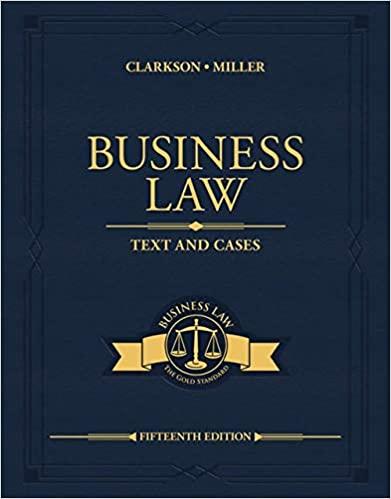Question
1. What important precedent did the Supreme Court establish in the 1919 case of Schenck v. U.S .; and, name and define the new precedent
1. What important precedent did the Supreme Court establish in the 1919 case of Schenck v. U.S.; and, name and define the new precedent the court set in Brandenburg v. Ohio(1969) that remains today:
2. In the area of so-called 'hate speech,' explain the Supreme Court's ruling in the R.A.V. v. St. Paul case in 1992...and what did the court say in the 2003 Virginia v. Black ruling concerning cross burnings;
3. Two-part question:
How many total Federal District Courts are there in the U.S....and, how many total Federal Appellate Circuits:
What four areas of law fall under Exclusive Federal Court jurisdiction?
4. The government may restrict speech or expression using Time-Place-Manner criteria; what is the CRUCIAL consideration for the constitutionality of T-P-M -- AND what important precedent did the Supreme Court set in the case Ward v. Rock Against Racism(1989)
5. Three-part question:
Name and define the two categories of libel:
What level of fault do private citizens have to prove in libel cases:
What are the two categories of 'Public figures:'
6. The 1964 New York Times v. Sullivan decision established that 'public officials (later broadened to include all 'public figures')would have to prove 'actual malice' to win a libel case. How did the Gertz v. Welsh case refine libel law:(Be specific - what three things did the Supreme Court say in their ruling on this important case):
7. Explain the significance of the Supreme Court's ruling in Tinker v. Des Moines Independent Community School District in 1969; and, how did the court rule in Bethel District v. Fraser in 1986...what was the KEY to the court's distinction between the two cases:
8. What was the significance of the Supreme Court's ruling in Texas v. Johnson(1989) and U.S. v. Eichman(1990); and, what was the court's ruling in United States v. O'Brien in 1968 - and what was the basis for the court's ruling in O'Brien's case:
9. Explain the Supreme Court's ruling in the following two cases dealing with Privacy - the 1999 'Media Ride-along case(Wilson v. Layne)....and the 2001 Bartnicki v. Vopper case. Give me the KEY rulings in each case:
10. In the following cases, indicate whether the Appeals Courts(the 9th Federal Circuit in two cases, and the California Supreme Court in one case)ruled that an invasion of
privacy had - or had not occurred:
Dieteman v. Time(1971):
Shulman v. Group W Productions(1988):
Deteresa v. ABC(1997):
- Explain the distinctions between the 1969 Federal Hate Crimes Law and the
Matthew Shepard-James Byrd, Jr. Act passed in 2009:
2. Define 'False Light'; and, explain the difference between false light and libel:
Step by Step Solution
There are 3 Steps involved in it
Step: 1

Get Instant Access to Expert-Tailored Solutions
See step-by-step solutions with expert insights and AI powered tools for academic success
Step: 2

Step: 3

Ace Your Homework with AI
Get the answers you need in no time with our AI-driven, step-by-step assistance
Get Started


